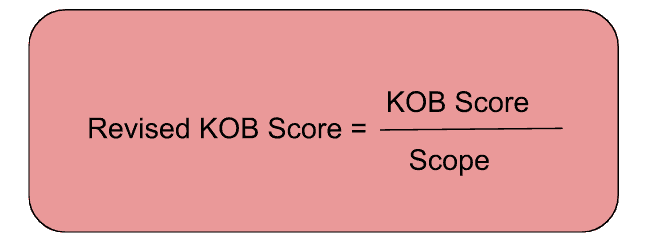SUPERCHARGE YOUR ONLINE VISIBILITY! CONTACT US AND LET’S ACHIEVE EXCELLENCE TOGETHER!
Have you ever started your Keyword research in any Keyword tool only to discover that all of your dream keywords have unimaginably high difficulty? Are you getting drowned in Competition and just can’t find an opportunity to create content and Rank as a new Website?

We have been there, and I assure you, no matter how bad the competition, you will always find content ideas to pursue, and you will always find stuff to rank for!
This is a problem faced by every business trying to get their sweet spot on Google. I will show you how professional agencies overcome this using KOB Analysis.
What is KOB Analysis?
KOB or Keyword Opposition to Benefit is a step-by-step method to research and understand the full scope of topics in a particular niche and prioritize them based on their feasibility to rank and business potential, which is determined by assigning a KOB Score.
No matter your niche, there are always topics worth pursuing and relatively easier to rank.
With this step-by-step guide, you will learn how to research the entire scope of topics in your niche and come up with laser-targeted keywords and a content plan to kickstart your SEO Journey.
Advanced Techniques for KOB Analysis
As the digital landscape continues to evolve, so do the tools and techniques available for conducting keyword research and analysis. Advanced techniques for KOB analysis go beyond traditional keyword research methods, offering marketers and businesses innovative approaches to uncovering strategic insights and opportunities. Let’s take a closer look at a few of these sophisticated methods:
1. Using Advanced Keyword Research Tools:
- Advanced keyword research tools such as SEMrush, Ahrefs, Moz, and SpyFu offer a wide range of features and functionalities to conduct comprehensive KOB analysis.
- These tools provide valuable insights into keyword competitiveness, search volume, trend analysis, and competitor data, allowing marketers to identify high-value keywords with precision.
- Features like keyword difficulty scores, SERP analysis, and backlink analysis empower marketers to make data-driven decisions and prioritize efforts based on strategic objectives.
2. Exploring Niche-Specific KOB Analysis Strategies:
- Different industries and niches present unique challenges and opportunities when it comes to SEO and keyword analysis. Therefore, it’s essential to tailor KOB analysis strategies to the specific needs and dynamics of each industry.
- Niche-specific KOB analysis strategies may involve conducting in-depth market research, understanding audience preferences and behavior, and identifying niche keywords and topics with high relevance and search volume.
- By focusing on niche-specific KOB analysis, marketers can uncover untapped opportunities, address specific pain points, and position their content or offerings effectively within their target market.
3. Incorporating Data-Driven Insights and Machine Learning Algorithms:
- In the era of big data and machine learning, incorporating data-driven insights and advanced algorithms can significantly enhance the accuracy and effectiveness of KOB analysis.
- Machine learning algorithms can analyze vast amounts of data, identify patterns, and predict keyword performance and trends with greater precision than traditional methods.
- By using machine learning algorithms, marketers can gain deeper insights into user intent, content relevance, and search behavior, enabling them to optimize their KOB analysis strategies for maximum impact.
- Integrating data-driven insights from analytics platforms such as Google Analytics and Google Search Console can provide valuable feedback and validation for KOB analysis efforts, helping marketers refine their strategies and achieve better results over time.
Advanced techniques for KOB analysis offer marketers and businesses powerful tools and methodologies for unlocking strategic insights and opportunities in the competitive digital landscape. By leveraging advanced keyword research tools, exploring niche-specific strategies, and incorporating data-driven insights and machine learning algorithms, marketers can elevate their KOB analysis efforts and achieve superior results in SEO and search engine rankings.
Finding Relevant Keyword Topics
First, we need to find who’s like us in the market. Basically, find a more similar competition that’s out there in the market currently ranking for our dream keywords.
Basically, it involves coming up with 1-2 seed terms that define your niche. For us, it’s SEO and Digital Marketing. Let’s see what Google has in store for us.
As an SEO service provider and marketing agency, we definitely do not count Wikipedia, WordStream or Search Engine Journal as our competitors. However, Neil Patel can be a competitor.
The similar result we get for digital marketing.
Now put that URL into Ahrefs or any Keyword Research tool. Go to the Anchors and Organic Keywords tab. There you will find a host of topics that you can explore for this keyword.
You can also change the original seed keyword to find even more topics.
Here’s what we found after a few hours of research.
You will get most of the data from Ahrefs, however, relevance is a column that you have to determine yourself. You can give it a score from 1-3 depending on how relevant and important is this keyword to your business.
Calculating the KOB Score and finding Opportunities
From Ahrefs, you will get the Traffic Value and the Keyword Difficulty data. Now it’s time to calculate the KOB Score. To put it in a formula, it looks like this:

If you are using AHrefs, you will get a difficulty score. Else you can calculate the difficulty score by multiplying the (Search Volume * CPC).
The KOB Score thus obtained gives a rough estimation of whether the particular topic is worth pursuing. Lower the KOB Score, the more suitable the term
By no means is this a completely reliable metric. Still, it is useful for better prioritizing our work and then applying a strategic layer of how to move forward with our content.
Finding The Actual Scope of Each Topic
We have found the KOB Score for each topic based on the analysis done so far. However, we are not quite done yet.
- Eliminate Higher Difficulty Keywords
We still need to find qualifying opportunities for our content marketing efforts. The best way to start is to eliminate all keywords with a keyword difficulty higher than your Ahref DR rating.
For example, if you are a DR 50 site, you should probably eliminate all Keywords with keyword difficulty of more than 70. If you are a new website, you perhaps should not target keywords with a difficulty of more than 30.
You can move that up to 50 since you will be researching topics that will be broad. Later you will go deep down researching keywords for each topic to find relevant content ideas for your articles.
- Add a Scope of Hours to Each Topic
With the remaining number of topics, you can add a scope of hours, which is an average estimation of the total time required to create all the necessary content to cover the topic completely.
With the scope defined, you can now calculate a revised KOB Score, which accurately scales the potential of that topic on a scale of 1-100.

This can drastically alter how you prioritize things because, once again, that big asset may require a significant amount of time to rank for. Still, it may not be worthwhile when you can do something very light and rank faster as a result.
Leveraging the Power of Competitor Analysis in KOB Strategy
While KOB analysis focuses on uncovering the most valuable keywords in your niche, one area that is often underutilized is competitor analysis. Many businesses solely focus on finding their own opportunities, but a critical part of KOB analysis is understanding what your competitors are doing to rank, and how you can leverage their weaknesses. By thoroughly analyzing competitors, you can fine-tune your own KOB strategy and uncover content opportunities you might have missed.
Here’s how competitor analysis can further enhance your KOB process and SEO strategy:
1. Identify Gaps in Competitor Content
In most cases, top-ranking competitors will already have comprehensive content strategies in place. By performing a detailed competitor analysis, you can identify gaps in their content. These are topics, subtopics, or related keywords that they have either ignored or haven’t fully covered.
For example, a competitor may rank well for broad keywords but have neglected long-tail variations, local search queries, or niche-specific questions. These gaps present the perfect opportunity for you to create better, more optimized content that fills in those voids.
How to Do It:
- To effectively leverage competitor analysis in your SEO strategy, using tools like Ahrefs or SEMrush is essential. These platforms allow you to dive deep into your competitors’ keyword strategies and discover which keywords are driving traffic to their websites. With this insight, you can identify opportunities to rank for similar keywords or find gaps in their content that you can capitalize on.
- By analyzing competitor pages, you can examine the keywords they rank for and assess their content depth. Are they fully covering a topic, or are there areas that you can elaborate on or improve? For instance, if your competitor provides a brief overview of a topic, you have the chance to create more comprehensive, valuable content that goes deeper into the subject.
- Additionally, tools like Ahrefs and SEMrush allow you to track the performance of competitor content. This helps you understand which types of content resonate most with their audience, whether it’s in-depth blog posts, videos, or case studies. By replicating and improving upon successful strategies, you can create engaging, high-quality content that not only targets similar keywords but also outperforms your competitors in search rankings.
2. Reverse Engineer Their Backlink Strategy
Backlinks remain one of the most important ranking factors in SEO. One way to boost your own SEO performance is to replicate or improve upon the backlink strategy of your competitors. By identifying where they’re earning links from and analyzing the types of content generating these backlinks, you can create your own backlink strategy.
How to Do It:
Backlink Research Tools and Content Partnerships
- Backlinks are one of the most crucial ranking factors for SEO. To gain an edge, analyzing your competitor’s backlink profile can provide invaluable insights. Tools like Ahrefs, Moz, or Majestic are powerful for this purpose. These platforms allow you to examine which high-authority sites are linking to your competitors. By identifying these backlinks, you can pinpoint opportunities to acquire similar links for your website. The key is to target backlinks from reputable sources that are directly relevant to your niche, as these will have the most significant impact on your rankings.
- Once you identify high-quality sites linking to your competitors, you can approach them for content partnerships. If a competitor has successfully earned backlinks from influential blogs or websites, consider reaching out to those same platforms. Offering to write guest posts, collaborate on interviews, or participate in joint content efforts can help you secure valuable backlinks from authoritative sites in your industry. This method of link building not only helps you boost your website’s SEO but also builds relationships with industry influencers. Always focus on acquiring backlinks from trusted sites with high Domain Authority (DA) to ensure you are improving your site’s credibility and visibility in search engines.
3. Examine Their User Engagement
Beyond backlinks and content, another vital metric to analyze is user engagement. User behavior signals to Google whether visitors find your website valuable. Pages with high bounce rates or low engagement often rank poorly, while those that foster interaction (like comments, social shares, and time on site) are favored by search engines.
By observing how competitors structure their content and encourage user engagement, you can adopt strategies that enhance your own user interaction metrics.
How to Do It:
- Engagement metrics are crucial for understanding how users interact with a website, providing insights into content effectiveness. Tools like Google Analytics and Hotjar allow you to track user behavior, such as average time spent on a page, bounce rates, and interaction with specific content. By monitoring these metrics, you can identify which pages or types of content capture the most attention and retain users longer. For instance, if blog posts or videos have high engagement, it indicates that visitors find them valuable. Similarly, analyzing social shares can help you gauge how well content resonates with your audience, as shared content often reflects user interest.
- To boost engagement on your own site, consider incorporating interactive elements. Features like quizzes, polls, and comment sections encourage users to actively participate, which can increase time on page and foster a sense of community. Additionally, clear calls to action (CTAs) prompt visitors to take the next step, whether it’s signing up for a newsletter, downloading a resource, or making a purchase. These elements not only improve user experience but also contribute to higher engagement rates, leading to improved SEO performance. By leveraging both engagement metrics and interactive content, you can create a more compelling and user-centric website.
4. Replicate Their Content Structure
The structure and format of content play a significant role in its ability to rank. Competitors who consistently perform well on certain keywords often have optimized content structures that encourage better indexing and ranking.
Replicating or enhancing the way competitors format their pages can help you create content that ranks higher. Whether it’s through the use of bullet points, headings, or featured snippets, understanding the optimal content structure for ranking is essential.
How to Do It:
- Page Structure Analysis: When analyzing a competitor’s content layout, it’s essential to look at the formatting techniques they employ to engage readers. Key elements include the use of bullet points, numbered lists, and FAQs. These formatting styles help organize information in a way that is easier for readers to scan and digest. Take note of how the competitor structures their content, including the length of the article. Longer articles often rank better in search results, but the quality and clarity of the content are just as important. Also, observe the use of images, videos, or infographics. Multimedia can significantly enhance content by providing visual explanations and making the page more engaging.
- Improvement Strategy: Once you’ve identified a competitor’s successful page structure, consider ways to improve upon it. Expand the content by adding more detailed and relevant information that fills any gaps. For instance, if the competitor’s article is missing important subtopics or fails to fully answer a user query, add those elements. Additionally, breaking up the text with multimedia like videos, infographics, and high-quality images can increase user engagement. Ensuring the content is easily scannable with clear headings, subheadings, and concise paragraphs is essential for a seamless user experience and better ranking potential.
5. Track Competitor Keyword Shifts
SEO is not a static process, and the keyword rankings for your competitors can change over time. Competitors may rise in the rankings for certain keywords due to algorithm changes, new content, or backlink acquisition, while others may drop.
By continuously monitoring keyword shifts for your competitors, you can adapt your KOB strategy accordingly and seize new opportunities that arise.
How to Do It:
- Setting up alerts and analyzing new competitor pages are two powerful strategies to enhance your SEO efforts. By using tools like Google Alerts, Ahrefs, or SEMrush, you can continuously track changes in your competitors’ keyword rankings. Setting alerts for specific keywords allows you to stay informed about your competitors’ performance and identify any shifts in their SEO strategy. These insights can help you adjust your approach promptly, ensuring you stay competitive and capitalize on emerging trends before they gain traction.
- Additionally, keeping an eye on new competitor pages is equally crucial. When a competitor starts ranking for new keywords or publishes fresh content, it’s essential to analyze it for potential opportunities. Look for keywords they are targeting, the content structure they use, and how they’re engaging their audience. By understanding what’s working for them, you can tailor your strategy to target similar keywords or even build upon their content with more in-depth and valuable resources. This can help you not only compete with their rankings but exceed them by providing even more relevant, comprehensive content for your audience. Regularly monitoring competitor activity helps you stay ahead in the SEO game and refine your strategy for better results.
6. Learn from Competitor Failures
It’s also crucial to look at what isn’t working for your competitors. Every SEO strategy includes trial and error, so identifying their failed attempts can help you avoid making the same mistakes. For example, you might see that a competitor’s content was penalized due to keyword stuffing, or they launched a campaign that didn’t get much traction.
By studying what doesn’t work for your competitors, you can refine your KOB strategy and avoid common pitfalls that could harm your site’s SEO performance.
How to Do It:
- Penalty detection and engagement analysis are critical aspects of competitor analysis in SEO. Penalty detection involves using tools like SEMrush or Ahrefs to monitor if competitors have experienced significant drops in rankings or penalties. These drops can occur due to penalties from Google, often for violating search engine guidelines, such as engaging in black-hat SEO techniques like keyword stuffing, unnatural backlinks, or cloaking. Identifying these issues in your competitors’ strategies allows you to avoid similar pitfalls and ensure that your SEO tactics remain within the guidelines set by search engines.
- On the other hand, engagement failures can signal ineffective content strategies. By analyzing competitors’ pages with high bounce rates or low engagement on social media, you can identify what doesn’t work. For instance, poorly structured content, lack of interactivity, or irrelevant information can lead to high bounce rates. By avoiding these mistakes, you can create content that resonates better with your target audience. Focus on optimizing for user experience, crafting engaging content, and ensuring that your pages encourage deeper interaction. Understanding why competitors’ content fails can help you refine your own approach, leading to improved engagement, better user retention, and ultimately, higher rankings.
Conclusion
So, that final step of scoping and comparing it to the KOB score essentially gets you a new, more data-driven assessment to prioritize your content appropriately and make an impact faster, making sure it’s leveraged against the actual time to create that content to have the greatest impact for your business.
The Entire sheet would hardly take 5-6 hours to create, and for a large enough business, it might take a day, but not more than that.
With this done, you now have a well-researched and data-driven approach to pursue topics you can actually rank for. Now all you need to do is niche down on each topic to find a cluster of content ideas and make it rank.
You can follow our in-depth guide on Topic Clustering to make sure you are building Content Marketing Machine that bulldozes your way up the Google search rankings.
Reference > Build a Content Marketing Machine to Capture the Search Market using Topic Clustering.

Thatware | Founder & CEO
Tuhin is recognized across the globe for his vision to revolutionize digital transformation industry with the help of cutting-edge technology. He won bronze for India at the Stevie Awards USA as well as winning the India Business Awards, India Technology Award, Top 100 influential tech leaders from Analytics Insights, Clutch Global Front runner in digital marketing, founder of the fastest growing company in Asia by The CEO Magazine and is a TEDx speaker and BrightonSEO speaker.


